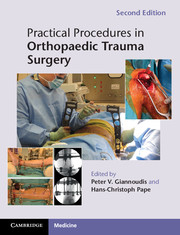Book contents
- Frontmatter
- Dedication
- Contents
- List of Contributors
- Preface
- Acknowledgements
- Part 1 Shoulder girdle
- Part 2 Upper extremity
- Part 3 Pelvis and acetabulum
- Part 4 Lower extremity
- 10 Section I: Extracapsular fractures of the hip
- 11 Section I: Fractures of the femoral shaft
- 12 Fractures of the patella
- 13 Section I: Fractures of the proximal tibia
- 14 Fractures of the ankle
- 15 Fractures of the foot
- Part 5 Spine
- Part 6 Tendon injuries
- Part 7 Compartments
- Index
10 - Section I: Extracapsular fractures of the hip
Published online by Cambridge University Press: 05 February 2014
- Frontmatter
- Dedication
- Contents
- List of Contributors
- Preface
- Acknowledgements
- Part 1 Shoulder girdle
- Part 2 Upper extremity
- Part 3 Pelvis and acetabulum
- Part 4 Lower extremity
- 10 Section I: Extracapsular fractures of the hip
- 11 Section I: Fractures of the femoral shaft
- 12 Fractures of the patella
- 13 Section I: Fractures of the proximal tibia
- 14 Fractures of the ankle
- 15 Fractures of the foot
- Part 5 Spine
- Part 6 Tendon injuries
- Part 7 Compartments
- Index
Summary
Indications
Sliding compression hip screw devices are used to stabilize:
Stable intertrochanteric hip fractures (Fig. 10.1.1).
Rotationally unstable, comminuted and vertical (Pauwels type 3) intracapsular fractures of neck of femur.
Preoperative planning
Clinical assessment
Pain localized in the affected hip side – radiation of pain to the knee.
Limb is shortened and externally rotated.
Assess and document the neurovascular status of the leg.
In young patients careful examination for other injuries must be made, as these fractures are a result of high-energy trauma.
A complete medical examination in elderly patients.
Radiological assessment
Anteroposterior radiograph and a lateral view of the afected hip to demonstrate the fracture geometry.
Anteroposterior radiograph of the pelvis to estimate the contralateral ‘normal’ neck-shat angle.
Preoperative consent
Obtain informed consent from the patient, including but not limited to risks, beneits, alternatives, complications and potential outcome.
Operative treatment
The World Health Organization (WHO) Surgical Safety Checklist should be used in the operating room.
- Type
- Chapter
- Information
- Practical Procedures in Orthopaedic Trauma Surgery , pp. 246 - 259Publisher: Cambridge University PressPrint publication year: 2014

